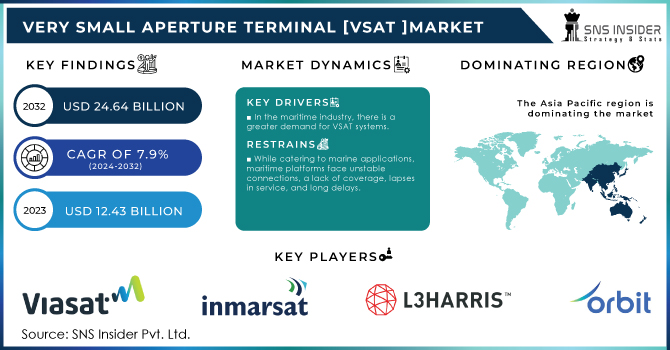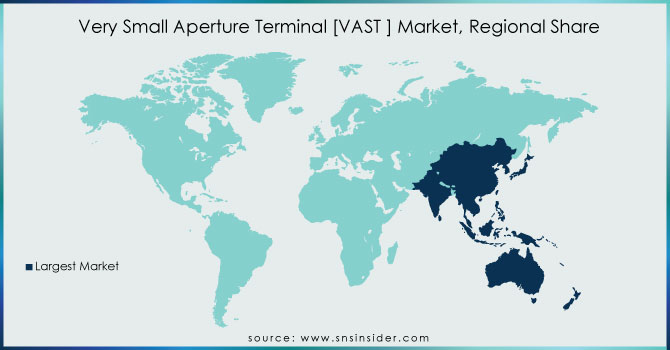Very Small Aperture Terminal [VSAT] Market Report Scope & Overview:

To get more information on VAST Market - Request Free Sample Report
The Very Small Aperture Terminal [VSAT] Market Size was valued at USD 12.43 billion in 2023 and is expected to reach USD 24.64 billion by 2032 and grow at a CAGR of 7.9% over the forecast period 2024-2032.
Very small Aperture terminal communication terminals are used to transmit and receive text, video, and audio text using Broadband Internet services. Terminals are 1.2 to 2.4 meters wide. They use geostationary satellites in the Ka, Ku, and C bands. There are two types of channels involved in this process which include a fixed station and a moving station. The VSAT network consists of a large channel called the harp and other sites located in remote locations connected to the geostationary satellite. These networks help to detect broadband wireless connections in uninstalled and remote areas that are not covered by wireless networks. There are three types of VSAT transfers that include demand for multiple access points, multi-time distribution , multiple channels per network company / one channel per network company. The VSAT terminal also provides additional services such as data transfer, local area network services and internet access.
Growing demand for advanced satellite imagery, rising popularity of high-resolution digital satellite aerial imagery among engineers, developers, and city planners to use the imagery for strategic planning, analysis, and evaluation, increasing adoption of VSAT due to technological advancements and the introduction of remote-sensing technology and image-enhancement equipment are expected to drive the market over the forecast years. The Global Very Small Aperture Terminal Market report offers a comprehensive analysis of the market. The report provides a comprehensive analysis of the market's key segments, trends, drivers, restraints, competitive landscape, and factors.
MARKET DYNAMICS
KEY DRIVERS
-
In the maritime industry, there is a greater demand for VSAT systems.
-
VSAT-equipped ships can provide high-speed broadband connections for business activities like ERP and video conferencing, as well as personal communication like email, video calling, and streaming.
RESTRAINTS
-
Connectivity issues at sea
-
While catering to marine applications, maritime platforms face unstable connections, a lack of coverage, lapses in service, and long delays.
OPPORTUNITIES
-
The number of LEO-HTS constellations is growing.
-
Telecom operators will be able to access previously unavailable networks and expand their reach to remote areas thanks to new low Earth orbit constellations. with flexible 4G and 5G technologies and high bandwidth
CHALLENGES
-
In the last few years, there has been an increase in cyber security breaches all over the world.
-
The growing use of smart shipping jeopardizes the integrity and dependability of monitoring systems.
THE IMPACT OF COVID-19
The VSAT market includes major players Gilat Satellite Networks, L3 Harris Technologies, Viasat Inc, Inmarsat Global Limited, and Orbit Communication System. These players have spread their business to various countries including North America, Europe, Asia Pacific, the Middle East, Africa and South America. COVID-19 has had an impact on their businesses. Industry experts believe that COVID-19 could affect VSAT production and services by 7-10% worldwide by 2020.
The rapid spread of COVID-19 in Europe, the US and Asia Pacific has led to a sharp decline in demand for VSATs worldwide, with a corresponding decrease in the revenue of various VSAT providers, service providers in all markets due to late delivery, production closures. , fewer workers in production facilities, and limited availability of equipment. As industry experts, the global VSAT demand is expected to fully recover by 2022.
In light of the Item, the market is bifurcated into Fixed Station and Portable Station. The accessibility of remote broadband network because of the use of the two stations will use the market. In light of the Application, the market is bifurcated into the Common and Military. Military applications are anticipated to hold the main CAGR in the projected period because of the utilization of high-goal satellite symbolism in essential preparation, examination, and assessment in military activities. Rough VSAT is the quickest developing portion of the VSAT market, by plan. The development of this fragment can be credited because of expanded use at distant areas and high-risk conditions, for example, oceanic, aeronautics, energy and power, and safeguard areas. There is a requirement for the VSAT framework to be safeguarded remotely from shock perils from outrageous natural and remote circumstances. Sea VSAT is the quickest developing portion of the VSAT market. The development of this portion can be credited because of interest for business ready, and higher information rates in business ships have driven the oceanic VSAT market. Business transport tasks incorporate functional security information, for example, crisis data, information connected with video checking utilizing IP-based CCTV frameworks, and telemetry information. Hughes Organization Framework, Cobham, KVH Enterprises, Intelsat, and Circle Correspondence Framework are significant suppliers of VSAT frameworks for business ships. A cross breed geography is the quickest developing fragment of the VSAT market, by Organization design. The development of this section can be credited because of its high information dependability and high resistance capacity. This geography's most significant benefit is consolidating the qualities of various geographies. For example, network geography has amazing information unwavering quality, and star geography has high resilience capacity, and both these two capacities work at the same time in half breed geography
KEY MARKET SEGMENTATION
By Design
-
Rugged VSAT
-
Non-rugged VSAT
By Product
-
Fixed Station
-
Mobile Station
By Application
-
Civil
-
Military
By Solution
-
Equipment
-
Support Services
-
Connectivity Services
By Platform
-
Land VSAT
-
Maritime VSAT
-
Airborne VSAT
By End-Use
-
Broadband / Data Networks
-
Voice Communications
-
Private Network Services
-
Broadcast
-
Others
REGIONAL ANALYSIS
The Global Very small aperture terminal (VSAT) market is divided into four regions: North America, Europe, Asia Pacific, and the Rest of the World. The Asia Pacific region will hold the largest market share due to the need for satellite broadband communication to obtain accurate and timely information for disaster management in this disaster-prone region. VSAT is also used to manage and analyse risky activities such as mining.

Need any customization research on VAST Market - Enquiry Now
REGIONAL COVERAGE:
-
North America
-
USA
-
Canada
-
Mexico
-
-
Europe
-
Germany
-
UK
-
France
-
Italy
-
Spain
-
The Netherlands
-
Rest of Europe
-
-
Asia-Pacific
-
Japan
-
south Korea
-
China
-
India
-
Australia
-
Rest of Asia-Pacific
-
-
The Middle East & Africa
-
Israel
-
UAE
-
South Africa
-
Rest of Middle East & Africa
-
-
Latin America
-
Brazil
-
Argentina
-
Rest of Latin America
-
KEY PLAYERS
The Major Players are Viasat Inc, Inmarsat Global Limited, Orbit Communication System, Gilat Satellite Networks, L3 Harris Technologies, Gigasat, GomSpace, Imtech Marine, Mitsubishi Electric, ND Satcom, Newtec, and other players.
| Report Attributes | Details |
|---|---|
| Market Size in 2023 | US$ 12.43 Billion |
| Market Size by 2032 | US$ 24.64 Billion |
| CAGR | CAGR of 7.9% From 2024 to 2032 |
| Base Year | 2023 |
| Forecast Period | 2024-2032 |
| Historical Data | 2020-2022 |
| Report Scope & Coverage | Market Size, Segments Analysis, Competitive Landscape, Regional Analysis, DROC & SWOT Analysis, Forecast Outlook |
| Key Segments | • By Design (Rugged VSAT, Non-rugged VSAT) • By Product (Fixed Station, Mobile Station) • By Application (Civil, Military) • By Solution (Equipment, Support Services, Connectivity Services) • By Platform (Land VSAT, Maritime VSAT, Airborne VSAT) • By End-Use (Broadband / Data Networks, Voice Communications, Private Network Services, Broadcast, Others) |
| Regional Analysis/Coverage | North America (USA, Canada, Mexico), Europe (Germany, UK, France, Italy, Spain, Netherlands, Rest of Europe), Asia-Pacific (Japan, South Korea, China, India, Australia, Rest of Asia-Pacific), The Middle East & Africa (Israel, UAE, South Africa, Rest of Middle East & Africa), Latin America (Brazil, Argentina, Rest of Latin America) |
| Company Profiles | Viasat Inc, Inmarsat Global Limited, and Orbit Communication System, Gilat Satellite Networks, L3 Harris Technologies, Gigasat, GomSpace, Imtech Marine, Mitsubishi Electric, ND Satcom, Newtec, and other players. |
| DRIVERS | • In the maritime industry, there is a greater demand for VSAT systems. • VSAT-equipped ships can provide high-speed broadband connections for business activities like ERP and video conferencing, as well as personal communication like email, video calling, and streaming. |
| RESTRAINTS | • Connectivity issues at sea • While catering to marine applications, maritime platforms face unstable connections, a lack of coverage, lapses in service, and long delays. |

